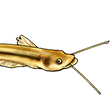MatsP wrote:I always get in trouble when identifying these, but my feeling is that this is the "real"
(aka L190) from Rio Orinoco drainage, rather than the L027{a, b, c} variants from Brazil. The Brazil species looks to have a longer/more streamlined nose if nothing else.
I disagree Mats, I think this fish is L027 Xingu. The Xingu's have the much higher angled 'block' head, the longer more slender heads are seen in the Tocantins and so called 'Thunder Panaque'. The Cat-elog lacks adult
but look at picture 4 and here on L-Welse
http://www.l-welse.com/reviewpost/showp ... product/37 for adults.
MatsP wrote:I'm also of the opinion that these fish are one species that is widespread throughout the Northern parts of South America - so throughout the entire Amazon basin and the Guyana shield areas. Like many widespread species, they vary depending on location.
And I would agree that it's a "she" - the cheek odontodes would be much more visible if it was a male.
I'm also starting to think this as well, the only differences I've seen are slightly different body shapes, potential size and mouth structure (as well as colour variations). But I don't know whether this could amount to separate species. On the cheek odontodes, I read in Ingo Seidel's book that females have been found to develop them also, but I don't know whether males can also, not develop them.
Anyway, Its a beautiful fish, my absolute favourite plec, I have 6 but none more than 6" yet.








